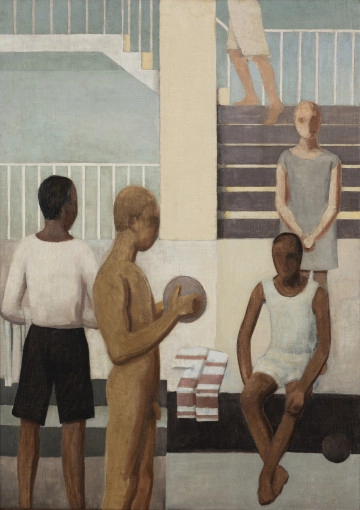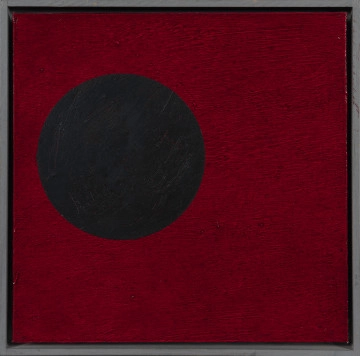
Treppe mit vier Figuren | Staircase with Four Figures
1931
National Museum in Szczecin
Part of the collection: European classics of modernity
Friedrich Bernhardt (1894–1986) was one of the most important leftist artists and cultural animators in interwar Szczecin. Born and raised in the Berlin district of Lichterfelde, he grew up in a milieu of the capital’s technical intelligentsia, surrounded by the sculptures of his grandfather, August Rudolf Bernhardt, a pupil of the neoclassicist Ernst Rietschel. At the age of ten, Friedrich joined the scouting movement, which fostered a love of nature, landscape sketching during excursions, sailing, and the alternative lifestyle promoted by the reform movement.
Bernhardt’s education at the preparatory school for shipbuilding at the Charlottenburg Polytechnic was interrupted by the outbreak of World War I and his service in the navy. While stationed in Heligoland and Flanders, he was discovered by the war artist Franz Eichhorst, who helped him enrol in a portrait and figure drawing course led by Florimond van Acker at the Bruges Academy between 1916 and 1918. Simultaneously, Bernhardt resumed his general education and obtained a “wartime” school-leaving certificate in Ghent in 1918. Following Professor Ferdinand Spiegel, whom he had met in Bruges, he transferred to the Berlin State School of Art, where he graduated as a drawing teacher in 1921. During this period, he became acquainted with the avant-garde Émile Jaques-Dalcroze School of Rhythmic Gymnastics in Hellerau, near Dresden. There, he met his future wife, Karen Munk, whom he married in 1923 in Szczecin. The couple settled in Pogodno, where their two sons were born.
From April 1922, Bernhardt worked at the Friedrich Schiller Realschule in Szczecin and later at the Otto von Bismarck Realschule. A dedicated mentor to young people and an innovative art teacher, he founded a local branch of Wandervogel, a youth hiking and cultural movement.
In 1925, Bernhardt became chairman of the Pomeranian District Group of the Reich Association of Visual Artists. His participation in two courses taught by Johannes Itten in February 1928 and March 1929, organised for students and supporters of the Szczecin School of Arts and Crafts, played a key role in his artistic development. His acquaintance with Bauhaus graduates Kurt Schwerdtfeger and Elsa Mögelin, as well as with Gregor Rosenbauer, the school’s director, and Walter Riezler, an art historian and director of the Municipal Museum – who was also a theorist of the Werkbund movement – strengthened the constructivist impulses in Bernhardt’s work.
He proposed that they join New Pomerania, a group promoting avant-garde artistic trends in the region. At the group’s first exhibition at the Szczecin museum, which ran from 31 August to 28 September 1930, Bernhardt presented a landscape from this period, Stettin I. This work combined his passion for maritime themes with a newly adopted geometric visual language.
Szymon Piotr Kubiak
Author / creator
Object type
painting
Technique
oil technique
Material
fibreboard
Origin / acquisition method
donation
Creation time / dating
Creation / finding place
Owner
The National Museum in Szczecin
Identification number
Location / status

Bernhardt, Friedrich
1931
National Museum in Szczecin

Radke, Marek
2008
National Museum in Szczecin

Radke, Marek
1994
National Museum in Szczecin
DISCOVER this TOPIC
Castle Museum in Łańcut
DISCOVER this PATH
Educational path
0/500

We use cookies to make it easier for you to use our website and for statistical purposes. You can manage cookies by changing the settings of your web browser. More information in the Privacy Policy.
We use cookies to make it easier for you to use our website and for statistical purposes. You can manage cookies by changing the settings of your web browser. More information in the Privacy Policy.
Manage cookies:
This type of cookies is necessary for the website to function. You can change your browser settings to block them, but then the website will not work properly.
WYMAGANE
They are used to measure user engagement and generate statistics about the website to better understand how it is used. If you block this type of cookies, we will not be able to collect information about the use of the website and we will not be able to monitor its performance.